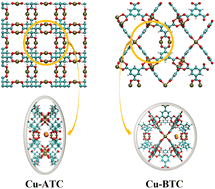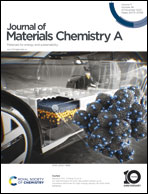Cu-ATC vs. Cu-BTC: comparing the H2 adsorption mechanism through experiment, molecular simulation, and inelastic neutron scattering studies†
Abstract
A combined experimental, inelastic neutron scattering (INS), and theoretical study of H2 adsorption was carried out in Cu-ATC and Cu-BTC, two metal–organic frameworks (MOFs) that consist of Cu2+ ions coordinated to 1,3,5,7-adamantanetetracarboxylate (ATC) and 1,3,5-benzenetricarboxylate (BTC) linkers, respectively. Experimental measurements revealed that Cu-ATC exhibits higher H2 uptake at low pressures than Cu-BTC, but saturates more quickly on account of its lower surface area. This results in a higher isosteric heat of adsorption (Qst) value at zero-coverage for Cu-ATC (12.63 kJ mol−1). Grand canonical Monte Carlo (GCMC) simulations of H2 adsorption in both MOFs produced isotherms that are in outstanding agreement with the corresponding experimental measurements at 77 and 87 K and pressures up to 1 atm. The simulations revealed that the H2 molecules initially bind onto the Cu2+ ions of the copper paddlewheel ([Cu2(O2CR)4]) units in both MOFs. In Cu-ATC, however, a H2 molecule can interact with two Cu2+ ions of adjacent paddlewheels simultaneously, which provides for a favorable, synergistic interactions. The INS spectra of H2 adsorbed in Cu-ATC and Cu-BTC showed neutron energy transfer peaks occurring at approximately 7.5 and 8.9 meV, respectively; these peaks correspond to the binding of H2 onto the open-metal sites in both MOFs. The lower energy peak for Cu-ATC indicates that the adsorbed H2 molecules experience a higher barrier to rotation and a stronger interaction with the host relative to Cu-BTC. These results were supported by two-dimensional quantum rotation calculations. This study demonstrates how differences in the H2 adsorption mechanism between two prototypal MOFs with copper paddlewheel units can be discerned through a combination of experimental measurements and theoretical calculations.



 Please wait while we load your content...
Please wait while we load your content...